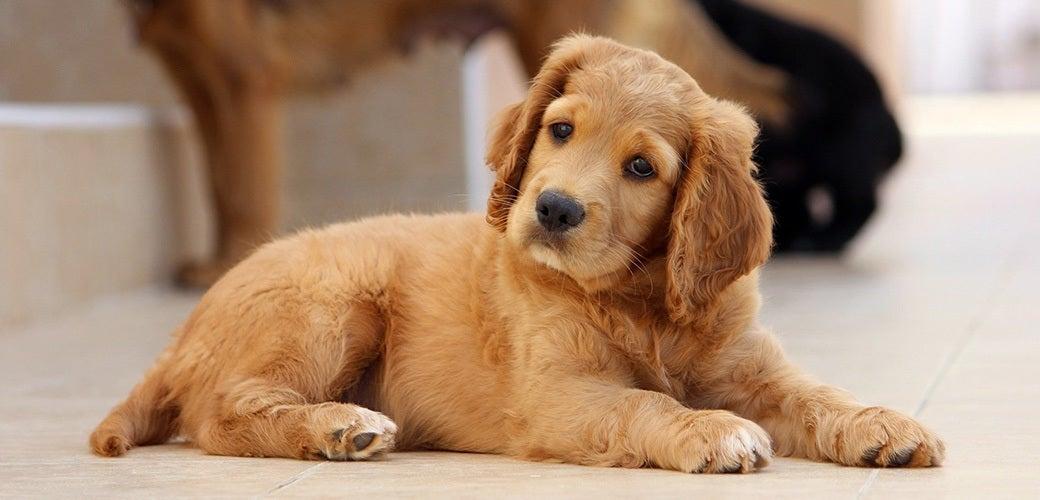
New puppy at home.

Welcoming a new puppy into our home can prove a stressful but important moment for the puppy. Here are some tips for managing this crucial time...
Just as humans do, animals bond with and have an affinity towards their family. They prefer the safety and comfort of their family’s company and dislike separation from them. When we bring a puppy into our home, it is important to keep in mind that this baby animal has spent all of their life surrounded by the warm bodies of their mother and siblings.
When we move this puppy into our home, we are actually separating them from their family, so it should be no surprise that there will be some initial anxiety and grief on the puppy’s part. Separation anxiety is a normal part of acclimating to a new home and family, and gentle patience is called for.
Think of it from an evolutionary point of view… all of the traits that began when dogs were still wild and continue because they have helped to keep the dog species alive. A vulnerable puppy that is separated from their family is at risk of being attacked and killed by predators. In order to discourage their mother from leaving for long periods, they cry, resulting in the mother dog staying close in order to keep them quiet and therefore ensuring their survival.
It is this natural instinct that still prompts puppies to whine, howl, squeal and demonstrate restlessness when they are separated from their families. For the first few days, or weeks, it is natural for a puppy to have trouble falling asleep in their new environment. They often feel vulnerable and afraid as they adjust to the absence of their canine brood.
Day one in the new home will be the most frightful for them – and the most challenging for you to lay the groundwork for your relationship with your puppy.
On this first night, the puppy is going to feel their new aloneness most keenly. A lot of people will respond to the whines and squeals of a puppy by placing them far from earshot, such as in a basement or garage. Or, the puppy may be placed in a cage to keep them from escaping and scratching at doors. In such a situation their sense of insecurity increases and they will whine and squeal as loudly as they can, perhaps until dawn.
Of course, by putting them in the basement we have temporarily avoided the disturbance caused by the puppy so we can get some sleep, but most veterinarians advise against this practice, saying that the intense anxiety caused by this practice could result in behavioural problems for the dog as they grow.
Security, not Coddling
So the question is where to make a spot for your puppy to sleep during her first days in your home. The first thing to consider is making a place where the puppy will not feel isolated. This can be a challenge! Some people feel comfortable keeping their dogs in the bedroom on a dog bed or designated blanket on the floor.
This can be good for giving the puppy a much needed sense of security – however, it’s probably best if you do not take the puppy into bed with you.
Despite this, there are those who feel very comfortable with taking their pets into their beds and allowing them to sleep there every night. In fact, this practice has its own practical applications: dogs are a wonderful source of warmth on frigid winter nights (ever wondered where the old idiom “three dog night” came from?) They have already made up their minds about where their dog will sleep and are not the ones we are speaking to here.
Not everyone wants a dog in their bed all the time, and if you are not sure whether you will or not, it is best not to. If you do take the puppy into your bed just to comfort them, it can lead to some behavioral problems later if you should decide that you do not want the dog in your bed every night after all.
Using a Crate
The best compromise can be setting a crate up in the bedroom or just outside of the open bedroom door. This way, the puppy can hear your sleeping sounds and you can verbally comfort her from close by. One other thing to consider about crating the puppy in those early nights is that puppies are unlikely to urinate where they sleep, so you can be sure that the puppy will not get up in the night and urinate on the floors.
And speaking of “going”, before going to bed, take the puppy outside so that they can relieve themselves. Getting into the habit of walking before bed has another advantage besides keeping the puppy from needing to urinate during the night – they will also get tired out and will be more likely to sleep soundly and less likely to disturb you as you sleep.
Again, remember that the puppy in not used to being alone in a crate. They will feel anxious and uncomfortable and are likely to make a lot of noise. It is best to ignore the puppy’s whines as much as possible. If you pay too much attention they will learn that this is a good method for getting you to come pet them.
When Nature Calls
Along with going out before bed, going out first thing in the morning should also become a habitual morning ritual. Puppies will typically relieve themselves in small amounts several times before they have finished an outing. Once they have finished, praise with a pat and perhaps a small training treat and say a few praising words to let them know they have done the right thing.
One of the most important messages you can send to your puppy in those first days is that they are cared for and wanted, just as you would show those feelings toward a human child. This increases the chances that your puppy will attach to you in a healthy and confident way, without anxiety, and will grow to be a friendly, affectionate, loyal and obedient dog.

